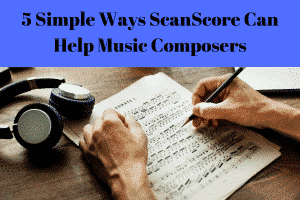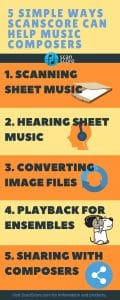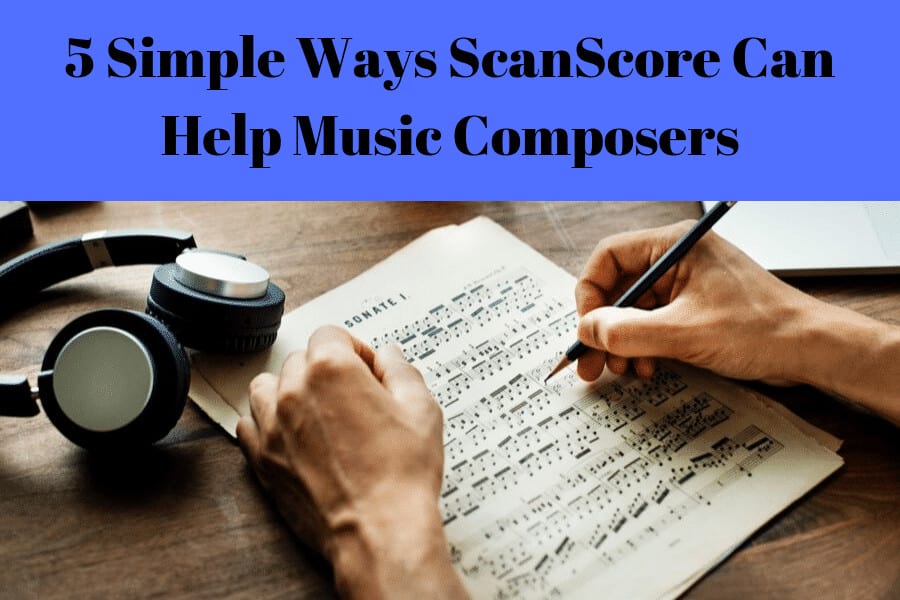In this article, we look at how ScanScore can help music composers.
Are you a music composer looking for help with some of your music technology?
Is scanning and notation sheet music a pain for you?
Does it all get in the way of your creative process?
Don’t worry! It’s a common problem, and one of the many reasons ScanScore was created. For those who take part in the creation of new art, it can be distracted trying to digitize sheet music when all you want to do is get to creating.
Take a look here for 5 simple ways ScanScore can help music composers such as yourself.

What Is ScanScore?
At its core, ScanScore is a program that helps you more easily scan, edit, and export sheet music and image files into music XML for later editing using your favorite, dedicated notation software.
ScanScore was developed by a small team in Germany to fill the music scanning gap which is missing from most people’s music technology setup.
ScanScore uses the most advanced and modern Optical Music Recognition techniques to provide the most accurate and streamlined scan of sheet music and sheet music images on the market.
For more information, check out this introductory video of the program:
https://www.youtube.com/watch?v=BWya9-SuxUw
5 Simple Ways ScanScore Makes Your Life Easier
In this section, we’ll discuss the ways ScanScore can make your life easier as a music composer. Take a look and see if any of these meet your needs.
If it does, hop on over to the ScanScore Products page to find the version which is right for you.
#1 Scanning Physical Sheet Music To Convert To MusicXML
The first and most obvious way ScanScore can help you is through the use of its scanning and converting program. This is the first intent of the program, and it does this job excellently.
As a world-class composer, you’re probably used to studying the works of other composers. After all, J.S. Bach was known for sneaking out of bed late at night to copy the works of the great composers before him.
He even was said to have credited this studying of other masters’ works as the main reason he was so prolific as a musician.
Luckily for us, in this modern age, we have access to many digital forms of pieces and sheet music made by others.
However, there are going to be some pieces you may never find online. You’re going to have to order or go pick up physical copies at the library.
When you do, the pieces often have a small checkout window or can’t be taken out at all. If you really wanted to dig into the music notation, this is a big problem.
Unless you have ScanScore!
Using the app or scanner, you can take an image of the sheet music and have it uploaded instantly to the program.
Then, ScanScore will scan the image instantly into music XML, and you can play with the notation to your heart’s content.
#2 Hearing Sheet Music On The Spot
Along the same lines, you may find yourself one day looking at a piece of physical sheet music and listening along with a professional recording.
As you listen, you hear something particularly moving you want to dig into, but you’re unsure where the audio file this was located.
Fumbling around, you may get frustrated and move on without a good understanding of how the other composer created this, and now you’re missing a technique that could improve your own writing.
ScanScore can help with this. By quickly scanning into the program, ScanScore can instantly playback (with piano) the sound of the sheet music.
This can help you quickly isolate the important section and learn from it, thereby improving your own understanding and skills.
#3 Converting Image Files/PDF To MusicXML
An important gig and skill for the composer to have is scoring and arranging. You’ll often be asked to arrange or rescore something for a different group of instruments.
In the past, composers often offered several arrangements of their own work.
This skill in practice is also great for practice and deepening understanding of how to use specific timbre to create new sounds.
However, as many will agree, the most difficult and grinding part of this process is inputting all the image files or PDFs from the original into your favorite notation program.
With ScanScore, this will only take minutes!
ScanScore can import an image or PDF and then, with a few corrections, export to music XML for quick arranging and editing.
#4 Playing Sheet Music For Ensembles
One of the most exciting moments as a composer is having the ensemble play your music for the first time.
If you’re lucky, the ensemble is very skilled and will be able to handle the performing and rehearsing of the piece without much trouble.
Unfortunately, this isn’t always the case, especially if your piece has some difficult rhythms or harmonies.
As a musician, I’ve always found that listening to a piece and getting the parts in my ear helps me perform a part better by a hundredfold. After all, music is, at its core, and aural art.
To help a struggling ensemble understand the general idea of the sound of your piece, it may be helpful to have it played for them.
Without the audio file handy, you can always use ScanScore to simply scan and playback the part for the musicians.
Once they’ve got it in their ear, you’ll be amazed at how smoothly the part is played after that.
#5 Sharing Work With Other Composers
As a composer, you may not want to share your work with others before you feel it’s ready. This is understandable; composing and creating is a very personal and intimate experience.
However, just like authors and other creators, you can’t get away with keeping your work all to yourself. By sharing and learning from each other, you’ll be shocked at how each piece can be improved drastically.
ScanScore can make this easier to do. It can play your compositions on the spot for other people, or you can scan in edits other people have written.
You could also make scans (with permission, of course) of other composers’ works for further study.

Which Programs Does ScanScore Work With?
ScanScore doesn’t directly work with other programs, but, instead, it converts images into musicXML for later editing.
Almost every major notation program uses musicXML as their base file type. This file type is popular because of its universal usage and accurate information retention.
For more details on how to use ScanScore in relation to a specific program, hop on over to our ScanScore Blog for details on the following notation programs:
- Finale
- Sibelius
- Dorico
- MuseScore
- Notion
How ScanScore Can Help Composers: Conclusion
We hope you enjoyed learning about the 5 simple ways ScanScore can help music composers.
All 5 of these ways boil down to ScanScore’s easy playback and accurate scanning abilities.
Let us know in the comments which reason is most appealing to you, or if you already use it, tell us about your experience!
Now go try the product out, and start composing!


Using your program to digitize music from MuseScore makes it so much easier for me to arrange my favorite pop songs
please send licience for my software that I have paid for.
Hi there,
in case you haven’t received our automatic license email please reach out to support@scan-score.com and we will assist you activating your license ASAP.
Best regards,
Gernot
ScanScore team